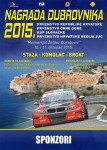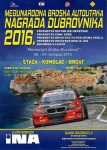| Title: | Nagrada Dubrovnika – Memorijal Željko Đuratović |
| Place: | Dubrovnik |
| Tracklength: | 3260 metres |
| Elevation change: | 180 metres |
| Altitude finishline: | 220 metres |
| GPS coordinates: | 42° 39′ 51.4794″ – 18° 8′ 4.5594″ |
| Website: | |
| Fastest Time: | 3:09,481 |
| Average Speed: | 123,88 km/h |
Is there missing or incorrect information on this page? Please let me know in the comments below, or send me an email.
| Date | Winner | Car | Time | Final | |
|---|---|---|---|---|---|
| 01-02/10/2011 | Niko Pulic |  | Coloni Nissan | 3:22,048 | Results |
| 13-14/10/2012 | Istvan Kavecz |  | BMW E90 | 3:14,679 | Results |
| 05-06/10/2013 | Istvan Kavecz |  | BMW E90 | 3:36,680 | Results |
| 11-12/10/2014 | Tomislav Muhvic |  | Mitsubishi Lancer EVO IX | 3:09,481 | Results |
| 10-11/10/2015 | Damir Masic |  | Mitsubishi Lancer EVO IX | 3:33,099 | Results |
| 08-09/10/2016 | Domagoj Perekovic |  | Mitsubishi Lancer EVO IX | 3:10,563 | Results |
| 07-08/10/2017 | Mario Jurisic |  | Opel Vectra STW | 3:08,375 | Results |
| 06-07/10/2018 | Domagoj Perekovic |  | Mitsubishi Lancer EVO IX | 3:10,593 | Results |
| 05-06/10/2019 | Norbert Nagy |  | BMW E92 | 3:20,454 | Results |
A free city state between 1358 and 1808, the city of Dubrovnik (until 1910 known under its Italian name Ragusa) reached the peak of its prosperity in the 15th and 16th century. The small state competed for trade and power In the Adriatic with similar states like Venice. But over land it also faced competition from the Turkish Empire. That Ragusa was under constant threat from rivals cannot be better illustrated than by the city’s most famous landmark; the citywalls around the old town. Everything about the walls is impressive: almost 2000m long, up to 6m thick, up to 25m high, and most importantly, still almost intact. Even the towers and fortresses still mostly exist. You can stroll around the walls as they are open to the public. The big St. Johns fortress in the harbour now holds museums.
The large defense works protected the innercity for centuries making Dubrovnik one of the best preserved cities in the whole of Europe. The city features on almost every “Most Beautiful Places” list you will find in any travel guide. It is therefore no surprise that the “Pearl of the Adriatic” has been a World Heritage Site since 1979.





